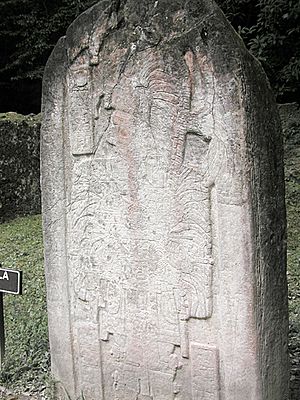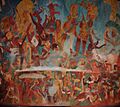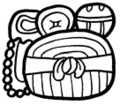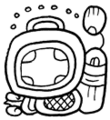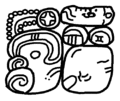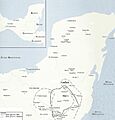Tikal–Calakmul wars facts for kids
Quick facts for kids Tikal–Calakmul Wars |
||||||||
|---|---|---|---|---|---|---|---|---|
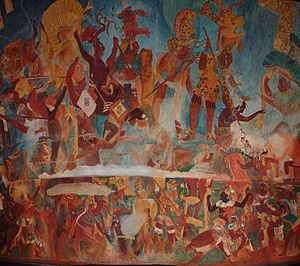 One of the first battles in the war between Bonampak and Yaxchilan is elaborately painted at Bonampak |
||||||||
|
||||||||
| Belligerents | ||||||||
| Tikal-affiliated city-states: Dos Pilas (until 648) Naranjo others |
Calakmul-affiliated city-states: Naranjo El Zotz El Perú La Corona Dos Pilas (from 648) others |
Third-party factions: others |
||||||
The Tikal–Calakmul wars were a long series of battles. They mostly happened between two powerful ancient Maya cities: Tikal and Calakmul. These wars also involved many smaller cities that were allied with either Tikal or Calakmul. These included places like Copan, Dos Pilas, Naranjo, Sacul, and Quiriguá. The city of Yaxchilan also played a small part in starting the first war.
Contents
Why the Wars Started
In 537, the leaders, called Ajaws, from Bonampak, Lakamtuun, and Calakmul were captured by the city of Yaxchilan. Bonampak and Lakamtuun stayed under Yaxchilan's control. But Calakmul fought back and took over Lakamtuun. This gave Calakmul a good position. It now had land both to the east and west of Tikal.
Even with this advantage, Calakmul was smaller than Tikal. Calakmul was a rich Maya city, but it had only about 50,000 people. Its whole kingdom had about 200,000 people. Tikal, on the other hand, was much bigger. It was home to almost half a million people. Both cities were like "superpowers" of their time. They led different groups of allied cities.
First Major War: 537–572

After taking over Yaxchilan and its smaller towns, Calakmul made friends with cities that were against Tikal. These included Caracol, El Perú, and El Zotz. El Zotz was very close to Tikal and had been against its powerful neighbor for a long time.
This conflict between Tikal, Calakmul, and their allies led to new ways of fighting for the Maya. They started building large, strong forts. These forts protected important travel routes. One famous fort was La Cuernavilla. It was built between Tikal and El Zotz.
Calakmul went on to conquer Naranjo in 546. Tikal and its kingdom were not completely destroyed. However, they lost a lot and became weaker after the war ended in 572.
"Cold War" Period
Historians sometimes call the time between the big wars a "cold war." During these years, there was still fighting, but no major battles or big political changes happened. There were small fights along the borders.
As Tikal slowly got stronger again, its smaller rivals, like El Zotz, became weaker.
Second Major War: 650–695
The second big war lasted from 650 to 695. One of the main places where battles happened was Dos Pilas. Tikal had built Dos Pilas as a military outpost. B'alaj Chan K'awiil, the brother of Tikal's king, ruled Dos Pilas.
Calakmul took over Dos Pilas after many years of heavy fighting. B'alaj Chan K'awiil first ran away. But then he decided to switch sides. He got his rule of Dos Pilas back, but this time he was under Calakmul's control. With help from his new allies, Dos Pilas then started a destructive "proxy war" against Tikal, its old mother city.
B'alaj Chan K'awiil claimed the royal title of Ajaw and the symbol of Tikal ![]() . He won the war against Tikal. He even captured and sacrificed Tikal's ruler, who was his own brother. From then until 695, Calakmul controlled Tikal. This was even after B'alaj's death.
. He won the war against Tikal. He even captured and sacrificed Tikal's ruler, who was his own brother. From then until 695, Calakmul controlled Tikal. This was even after B'alaj's death.
In 695, under the leadership of Jasaw Chan K'awiil I, Tikal won a big battle against Calakmul. This victory changed everything and ended the Second Tikal–Calakmul War.
Third Major War: 720–744
K'ak' Tiliw Chan Yopaat, the Ajaw of Quiriguá, was a very important person in the third war. Quiriguá used to be part of Copán. But in 734, K'ak' Tiliw Chan Yopaat led a rebellion against Uaxaclajuun Ub'aah K'awiil, the Ajaw of Copán.
Wamaw K'awiil, who was the kaloomte (a very high king) of Calakmul, traveled to Quiriguá. He formed an alliance with K'ak' Tiliw Chan Yopaat. Uaxaclajuun Ub'aah K'awiil was executed in 738, and Quiriguá became independent. By 744, Tikal had taken back El Peru and Naranjo. Calakmul had been defeated.
What Happened After
After losing its military power, Calakmul lost its northern areas and fell apart. The last known date recorded in Calakmul was 899, possibly 909.
Tikal, like most Maya cities, was also destroyed in what is called the Maya collapse. The wars might have helped cause this collapse. Other reasons could include too many people, diseases, and not enough food.
Images for kids
See also
 In Spanish: Guerras entre Tikal y Calakmul para niños
In Spanish: Guerras entre Tikal y Calakmul para niños


